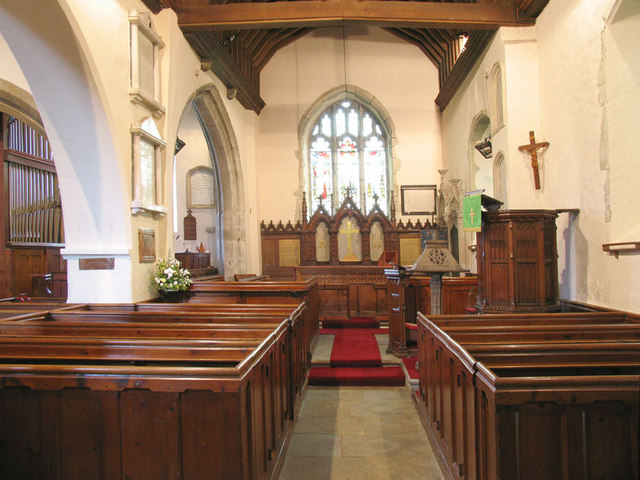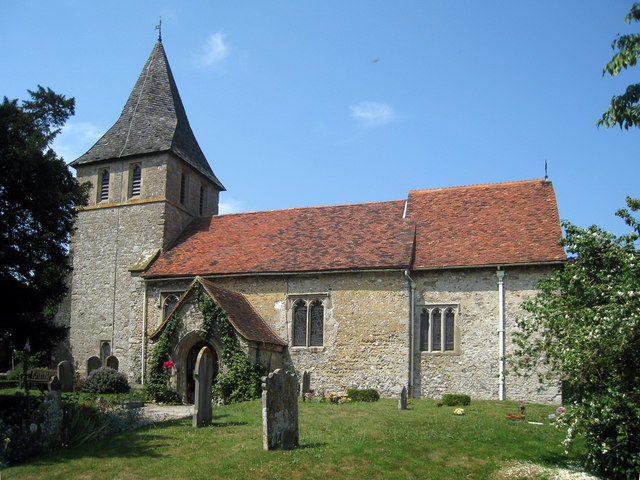|
St Martin Of Tours Church, Detling
St Martin of Tours is a parish church in Detling, Kent. Dedicated to Martin of Tours, the building was constructed in the 12th century with 13th and 15th-century additions and restoration carried out in the late 19th century. It is a Grade I listed building. The nave and chancel are of early Norman construction and built of flint with a plain tiled roof. The aisle to the north of the nave is Early English and is constructed of flint and local rag-stone. It was enlarged in the 1880s. The adjacent chapel on the north side of the chancel and the porch on the south side of the nave are Perpendicular Gothic. The tower is built in two stages of galletted rag-stone with diagonal corner buttresses. The timber- shingled broach spire was added in 1861 by R. C. Hussey. The roof structure to the chapel is original, but the rest of the roof was replaced in the 19th century. The church windows are of varying sizes and periods although mostly perpendicular in style. Over the doorway on ... [...More Info...] [...Related Items...] OR: [Wikipedia] [Google] [Baidu] |
Detling
Detling is a village and civil parish in the Borough of Maidstone in Kent, England. The parish is located on the slope of the North Downs, north east of Maidstone, and on the Pilgrims' Way. History and features The ''Cock Horse Inn'' was used to stable additional horses when required to take heavily laden coaches and wagons on the steep route up Detling Hill. The village is now bypassed by the A249 road, which opened in 1962. Jade's Crossing, a footbridge to the west of the village, opened in 2002 after a local resident, Jade Hobbs, was killed trying to cross the road. The Grade I listed village church is dedicated to Martin of Tours. The former airfield at the top of the hill was a Royal Navy Air Station during World War One, and an RAF station during World War Two. It was bombed by the Luftwaffe several times, with considerable loss of life. Its original area has been divided with some of the original hardstandings being used in a light industrial units area, part of t ... [...More Info...] [...Related Items...] OR: [Wikipedia] [Google] [Baidu] |
Flint
Flint, occasionally flintstone, is a sedimentary cryptocrystalline form of the mineral quartz, categorized as the variety of chert that occurs in chalk or marly limestone. Flint was widely used historically to make stone tools and start fires. It occurs chiefly as nodules and masses in sedimentary rocks, such as chalks and limestones.''The Flints from Portsdown Hill'' Inside the nodule, flint is usually dark grey, black, green, white or brown in colour, and often has a glassy or waxy appearance. A thin layer on the outside of the nodules is usually different in colour, typically white and rough in texture. The nodules can often be found along s and |
Congregational Church
Congregational churches (also Congregationalist churches or Congregationalism) are Protestant churches in the Calvinist tradition practising congregationalist church governance, in which each congregation independently and autonomously runs its own affairs. Congregationalism, as defined by the Pew Research Center, is estimated to represent 0.5 percent of the worldwide Protestant population; though their organizational customs and other ideas influenced significant parts of Protestantism, as well as other Christian congregations. The report defines it very narrowly, encompassing mainly denominations in the United States and the United Kingdom, which can trace their history back to nonconforming Protestants, Puritans, Separatists, Independents, English religious groups coming out of the English Civil War, and other English Dissenters not satisfied with the degree to which the Church of England had been reformed. Congregationalist tradition has a presence in the United States ... [...More Info...] [...Related Items...] OR: [Wikipedia] [Google] [Baidu] |
Pipe Organ
The pipe organ is a musical instrument that produces sound by driving pressurized air (called ''wind'') through the organ pipes selected from a keyboard. Because each pipe produces a single pitch, the pipes are provided in sets called ''ranks'', each of which has a common timbre and volume throughout the keyboard compass. Most organs have many ranks of pipes of differing timbre, pitch, and volume that the player can employ singly or in combination through the use of controls called stops. A pipe organ has one or more keyboards (called '' manuals'') played by the hands, and a pedal clavier played by the feet; each keyboard controls its own division, or group of stops. The keyboard(s), pedalboard, and stops are housed in the organ's ''console''. The organ's continuous supply of wind allows it to sustain notes for as long as the corresponding keys are pressed, unlike the piano and harpsichord whose sound begins to dissipate immediately after a key is depressed. The smallest po ... [...More Info...] [...Related Items...] OR: [Wikipedia] [Google] [Baidu] |
Yale University Press
Yale University Press is the university press of Yale University. It was founded in 1908 by George Parmly Day, and became an official department of Yale University in 1961, but it remains financially and operationally autonomous. , Yale University Press publishes approximately 300 new hardcover and 150 new paperback books annually and has a backlist of about 5,000 books in print. Its books have won five National Book Awards, two National Book Critics Circle Awards and eight Pulitzer Prizes. The press maintains offices in New Haven, Connecticut and London, England. Yale is the only American university press with a full-scale publishing operation in Europe. It was a co-founder of the distributor TriLiteral LLC with MIT Press and Harvard University Press. TriLiteral was sold to LSC Communications in 2018. Series and publishing programs Yale Series of Younger Poets Since its inception in 1919, the Yale Series of Younger Poets Competition has published the first collection of ... [...More Info...] [...Related Items...] OR: [Wikipedia] [Google] [Baidu] |
Buildings Of England
The Pevsner Architectural Guides are a series of guide books to the architecture of Great Britain and Ireland. Begun in the 1940s by the art historian Sir Nikolaus Pevsner, the 46 volumes of the original Buildings of England series were published between 1951 and 1974. The series was then extended to Scotland, Wales and Ireland in the late 1970s. Most of the English volumes have had subsequent revised and expanded editions, chiefly by other authors. The final Scottish volume, ''Lanarkshire and Renfrewshire'', was published in autumn 2016. This completed the series' coverage of Great Britain, in the 65th anniversary year of its inception. The Irish series remains incomplete. Origin and research methods After moving to the United Kingdom from his native Germany as a refugee in the 1930s, Nikolaus Pevsner found that the study of architectural history had little status in academic circles, and that the amount of information available, especially to travellers wanting to inform themsel ... [...More Info...] [...Related Items...] OR: [Wikipedia] [Google] [Baidu] |
Boxley Abbey
Boxley Abbey in Boxley, Kent, England was a Cistercian monastery founded c.1146 by William of Ypres, leader of King Stephen's Flemish mercenaries, and colonised by monks from Clairvaux Abbey in France. Some of its ruins survive, some four miles north-east of Maidstone. Notable events In 1171, the then abbot was one of those responsible for the burial of the murdered archbishop of Canterbury, Thomas Becket. In 1193 the abbots of Boxley and Robertsbridge journeyed to the continent to search for King Richard I, finally locating him in Bavaria. During 1512-13, the abbot appealed to the crown to arrest four of the monks, accusing them of rebelliousness. The relics The abbey was famous, and later infamous, for a relic known as the Rood of Grace, a wooden cross, the figure upon which was supposed to miraculously move and speak. In 1538 during the Dissolution of the Monasteries one Geoffrey Chamber, a "commissioner" employed by Thomas Cromwell to oversee the closure of the insti ... [...More Info...] [...Related Items...] OR: [Wikipedia] [Google] [Baidu] |
Richard Charles Hussey
Richard Charles Hussey, often referred to as R. C. Hussey, was a British architect. He was in partnership with Thomas Rickman from 1835, whose practice he assumed in 1838 with the latter's failing health; Rickman died on 4 January, 1841. Works *1838: Bishop Ryder Church, Birmingham *1838-1839 Christ Church, Clevedon *1841: St Matthew's parish church, Warwick Street, Rugby, Warwickshire *1843: rebuilt west front of Holy Trinity parish church, Coventry *1843–4: restorations to Chester Cathedral, Cheshire *1844: rebuilt St Peter's parish church, Barford, Warwickshire *1844: raised roof of SS Mary and Nicholas parish church, Littlemore, Oxfordshire *1845: west tower of All Saints' parish church, Old Grendon, Warwickshire *1846: St John the Evangelist parish church, Stoke Row, Oxfordshire *1846–8: rebuilt St Mary's parish church, Frittenden, Kent *1848–51: St John the Evangelist parish church, school and vicarage, Knypersley, Staffordshire *1849–50: St Saviour's parish c ... [...More Info...] [...Related Items...] OR: [Wikipedia] [Google] [Baidu] |
Broach Spire
A broach spire is a type of spire (tall pyramidal structure), which usually sits atop a tower or turret of a church. It starts on a square base and is carried up to a tapering octagonal spire by means of triangular faces. File:Leicester Cathedral panorama.jpg, Cathedral Church of Saint Martin, Leicester File:Broughton spire, Northants.JPG, Saint Andrew's Church, Broughton, Northamptonshire File:St John's, Weston.jpg, St John's Church, Weston, Runcorn, Cheshire, with its short broach spire File:Tower and broach spire of the Roman Catholic church of the Annunciation, New Mills, Derbyshire, January 2012.jpg, St Mary's Church, New Mills, Derbyshire File:Coddington Church - geograph.org.uk - 963136.jpg, All Saints, Coddington, Herefordshire Coddington is a hamlet and civil parish in eastern Herefordshire, England, about north of Ledbury.Ordnance Survey mapping The west side of the parish covers part of the Malvern Hills, an official Area of Outstanding Natural Beauty. Coddington s ... [...More Info...] [...Related Items...] OR: [Wikipedia] [Google] [Baidu] |
Roof Shingle
Roof shingles are a roof covering consisting of individual overlapping elements. These elements are typically flat, rectangular shapes laid in courses from the bottom edge of the roof up, with each successive course overlapping the joints below. Shingles are held by the roof rafters and are made of various materials such as wood, slate, flagstone, metal, plastic, and composite materials such as fibre cement and asphalt shingles. Ceramic roof tiles, which still dominate in Europe and some parts of Asia, are still usually called tiles. Roof shingles may deteriorate faster and need to repel more water than wall shingles. They are a very common roofing material in the United States. Etymology and nomenclature Shingle is a corruption of German meaning a roofing slate."Shingle" def. 1. Whitney, Willi ... [...More Info...] [...Related Items...] OR: [Wikipedia] [Google] [Baidu] |
Buttress
A buttress is an architectural structure built against or projecting from a wall which serves to support or reinforce the wall. Buttresses are fairly common on more ancient buildings, as a means of providing support to act against the lateral (sideways) forces arising out of inadequately braced roof structures. The term ''counterfort'' can be synonymous with buttress and is often used when referring to dams, retaining walls and other structures holding back earth. Early examples of buttresses are found on the Eanna Temple (ancient Uruk), dating to as early as the 4th millennium BC. Terminology In addition to flying and ordinary buttresses, brick and masonry buttresses that support wall corners can be classified according to their ground plan. A clasping or clamped buttress has an L shaped ground plan surrounding the corner, an angled buttress has two buttresses meeting at the corner, a setback buttress is similar to an angled buttress but the buttresses are set back from the ... [...More Info...] [...Related Items...] OR: [Wikipedia] [Google] [Baidu] |
Glossary Of Architecture
This page is a glossary of architecture. A B C image:Porch of Maidens.jpg, The Caryatid Porch of the Erechtheion, Athens, 421–407 BC D E F G H I J K L M N O P Q R S T ... [...More Info...] [...Related Items...] OR: [Wikipedia] [Google] [Baidu] |







